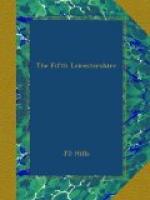The St. Quentin Canal, or Canal du Nord, as it is called further North, runs for the most part North and South. At Bellicourt, opposite the Americans, 1,000 yards North of our sector, it enters a tunnel and is for a considerable distance underground. At Bellenglise, opposite the right of our Divisional sector, it takes a sharp turn to the East, and runs, past Lehaucourt and le Tronquoy, for 21/2 miles before again turning South. The main Hindenburg Line followed the line of the Canal, just East of it. The Americans would attack the line above the tunnel, and North of them British Divisions would continue the advance far to the North. The 46th Division would attack with its right on Bellenglise, and a gap of 1,000 yards from its left to the Americans. South of us no attack would be necessary; for, once across the Canal, our right flank would be defended all the way to le Tronquoy by the Canal itself and this portion of the Hindenburg Line, which we should “roll up” from the flank. Tanks could not cross the Canal except over the tunnel at Bellicourt. Consequently the IXth Tank Battalion, allotted to our Division for the attack, would advance with the Americans, and, once in Bellicourt, turn south and join us to assist in the advance to the village objectives and the heights. To the Staffordshire Brigade was alloted the crossing of the Canal and the taking of the Hindenburg Line. Then, after a pause to allow the Tanks to come round, the Sherwood Foresters on the right and our Brigade on the left would sweep on, still under a barrage, to the final objective. We should have to deal with Magny village, the Right Brigade with Bellenglise and Lehaucourt. On the final objective there would be another pause, then, if all had gone well, the 32nd Division would come through to the “Red” Line of exploitation—another two miles still further East. Maps were issued with the objective of each unit shown in colour. The Staffordshires had the “Blue,” which was the Hindenburg Line, and the “Brown” further E. to hold till we came up; the 4th Leicestershires had the “Yellow,” which included Knobkerry Ridge, the 5th Lincolnshires the “Dotted Blue”—just beyond Magny village; we had the last of all, the “Green” line, including a sunken cross-roads, an old mill on some very high ground, and a small copse called Fosse Wood. It was argued that by this time either the attack would have failed and we should not be wanted, or, if successful, there could not be very much resistance; we were very weak after Pontruet, and this was considered the easiest task. The day chosen was September 29th—the time, dawn.




